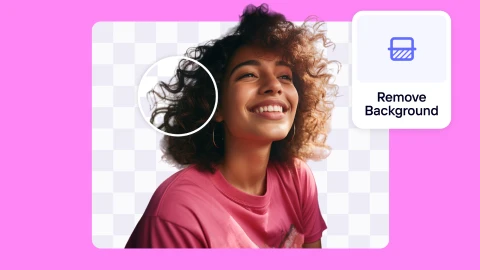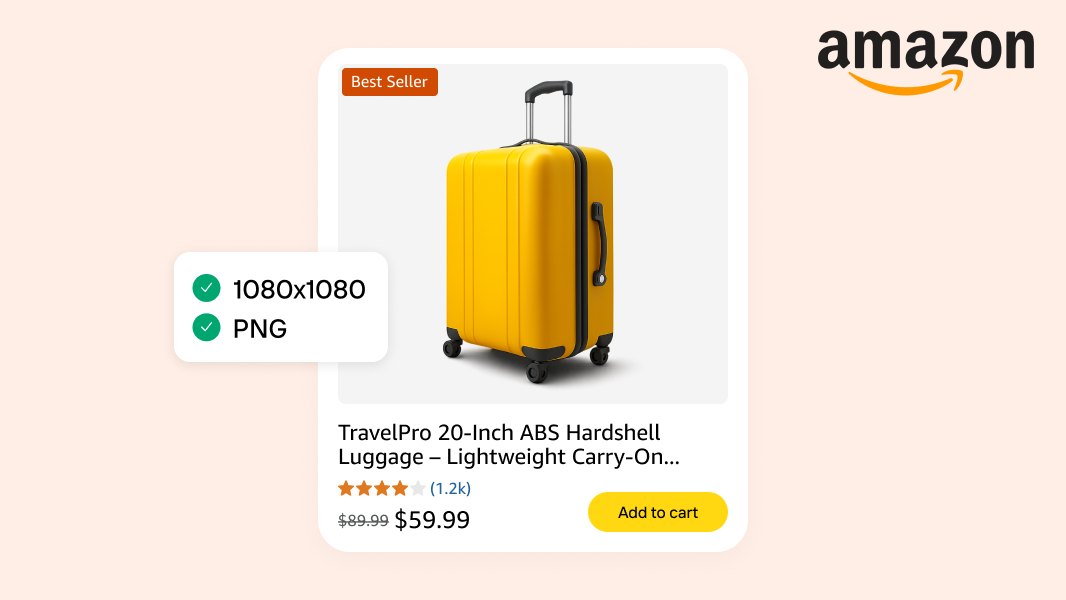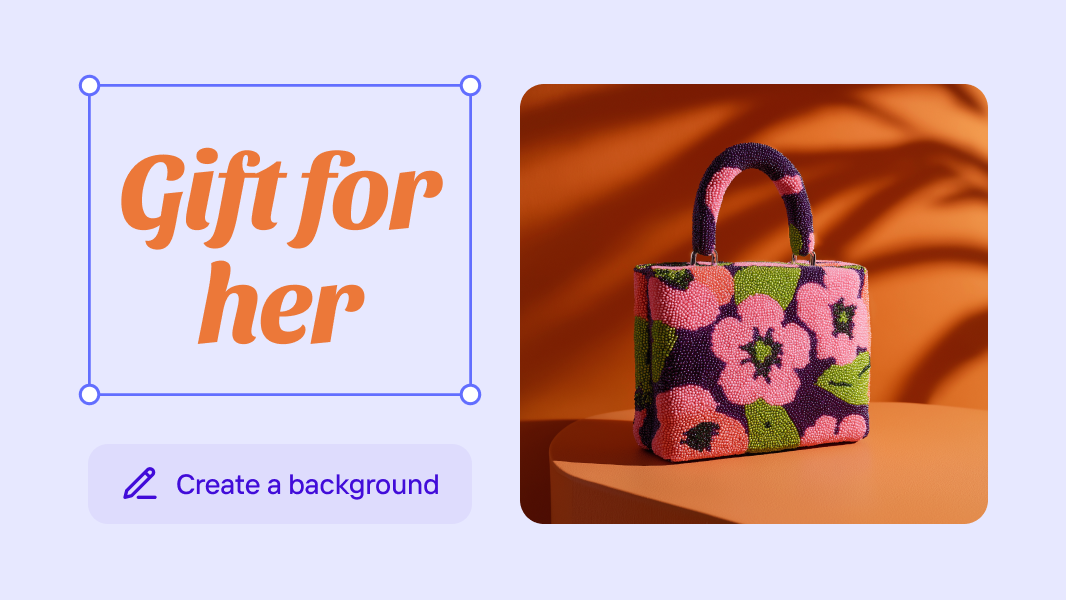Photoroom vs Photoshop: which tool wins for e-commerce visual marketing?
Trying to decide between Photoroom and Adobe Photoshop for e-commerce visual marketing? You’re in the right place.
Both tools can help you create sharp, professional visuals. They’re both awesome. But they approach the job in totally different ways.
Photoshop gives you full creative control. It’s the bonafide industry powerhouse for a reason. Photoroom, meanwhile, is all about getting clean, on-brand images out the door fast.
So the real question is: what kind of work are you trying to get done?
This guide breaks down both tools through the lens of real e-commerce workflows, so you can figure out which one actually fits the way you work.
Table of contents:
What is Photoroom?

Think of us as your AI-powered creative agency for commerce. One where you drop in a photo, and walk away with everything you need: a clean cutout, a pro-looking shadow, a perfectly sized image, and even a new background that fits your brand.
It’s built with marketplaces like Shopify, Etsy, and Amazon in mind. You get tools like AI Background Remover, AI Images and AI Backgrounds, batch editing, and export sizes optimized for the platforms you sell on.
No need to learn layers or mess with design software. Photoroom works on iOS, Android, and the web, with an interface that’s simple enough to master in minutes.
What is Adobe Photoshop?

Photoshop offers total control over every pixel, with tools for layering, masking, retouching, compositing, and now, powerful AI features like Generative Fill and Neural Filters.
It’s built for precision and flexibility, which makes it perfect for designers, photographers, and marketers who need to build detailed visual assets from scratch or fine-tune every element of a campaign.
But for most e-commerce sellers, that level of control comes at a cost. Photoshop’s desktop-first interface is dense, the learning curve is real, and the setup takes time. If you’re just trying to clean up product photos or publish listings quickly, it can feel like more tools than you actually need.
There are mobile apps, but the full power of Photoshop really lives on a desktop, and on a machine that can handle it.
So while Photoshop is no doubt an incredible tool, it’s usually too meaty and too complex for most users. That’s a gap that Photoroom helps to fill.
Photoroom vs. Photoshop: Toe-to-toe comparison
To recap: both Photoroom and Photoshop are powerful tools, but they serve different users. One is built for speed and simplicity (Photoroom). The other is built for full creative control (Photoshop).
Here’s how they stack up across the things that matter most to online sellers like you, including editing speed, AI tools, export options, and price.
| Feature or category | Photoroom | Photoshop |
|---|---|---|
| Core features | Background removal, product templates, instant shadows, ecommerce-focused UI | Layers, masking, advanced selection, generative AI, pro-level retouching |
| Batch editing and workflow | Batch edit up to 50 images with templates; optimized for speed and catalog consistency | Batch via Actions; flexible but takes time to set up and maintain |
| AI tools | AI backgrounds, shadows, expand; designed to automate listing prep | Generative Fill, Expand, Neural Filters—great for creative experiments |
| Ease of use | Simple, guided, beginner-friendly; fast onboarding; one click tools to edit and enhance product photos | Tons of tools, but a steep learning curve; not beginner-friendly |
| Export options | High-res JPG/PNG/WebP, transparent backgrounds, 250 free exports/month, no watermark | High-res exports in all formats, but setup for web/platforms takes more work |
| Pricing and plans | Free (250 exports), Pro: $89.99/yr, Teams: 3 seats included | Starts at $239.88/year per user; extra for full Creative Cloud |
Core feature comparison
Photoroom and Photoshop both tick the usual boxes: background removal, cropping, filters, and mobile-to-desktop access. But what each tool prioritizes is completely different.
Photoroom’s features are designed to help you create clean, conversion-ready e-commerce product images as quickly as possible. Photoshop, on the other hand, is a full creative suite whose toolset expands to the most complicated of workflows and creative requirements.
Shared features:
AI-powered background removal
Mobile and desktop editing (with different strengths)
Standard tools like crop, resize, brightness, and filters
Where Photoroom stands out:
Made for e-commerce and focused on listings, product pages, and marketplaces
One-tap background removal that’s shockingly accurate (users call it “natural” and “precise”)
Auto shadows and white backgrounds eliminate the need for a studio or re-shoots required to update and enhance existing impacts
Preset export sizes for Shopify, Etsy, Amazon, and more
Fast UI built for repeatable workflows, rather than advanced artistic exploration and creative deep diving
Generative AI tools that stage products in custom backgrounds, upscale images, and fix flaws without manual edits
See Photoroom’s suite of tools and features here.
“Photoroom is known for its AI-powered background removal feature, allowing me to easily and accurately remove backgrounds from photos. This provides me with a quick and efficient way to edit photos, particularly when it comes to background removal—the accuracy of background removal, makes the process smoother and more precise.”
Where Photoshop pulls ahead:
Full creative freedom for graphic design, composites, or complex edits
Layer-based editing and masking give total control over image composition
Advanced selection tools for high-precision cutouts
Generative Fill and Neural Filters open up powerful AI-driven edits
Pro-level color control and image retouching
Massive plugin support for extending the tool even further
Bottom line: If you want to get marketplace-ready images out the door fast, Photoroom is built for that. If you're crafting detailed visuals from scratch and need ultimate control, Photoshop is still the heavyweight.
Batch editing and workflow speed
If you need to process dozens, or even hundreds, of product photos, batch editing is a non-negotiable. This should be a feature that anyone selling online should look for in an image editing tool.
Photoroom: Built for speed and scale
Batch editing is available on the Pro plan, and it’s exactly what busy sellers need. You can process up to 50 images at once, removing backgrounds, cropping, resizing, and applying templates in just a few clicks.

If you sell high volumes, this can save you hours every week.
Photoshop: Powerful, but less plug-and-play
Photoshop’s batch workflow relies on “Actions”—custom sequences of edits you can record and apply to multiple images. It works well, but setup takes time. You’ll need to build and test each Action, and even then, changes often require manual tweaking.
It’s great if you want maximum flexibility and control over every layer or design element, but overkill if you just need to clean up product shots at scale.
Bottom line:
Photoroom is tailored to fast, repeatable editing. Photoshop can batch too, but it asks for more setup, more time, and more design know-how.
AI tools and smart features
Photoroom's AI helps speed up common tasks for e-commerce photo editing: removing backgrounds, generating clean scenes, resizing for marketplaces, and creating on-brand visuals in seconds. Photoshop’s AI tools are more about creative freedom—giving designers a blank canvas to experiment with content, style, and layout.
Photoroom’s AI strengths:
AI Backgrounds. Generate photorealistic, on-brand backdrops instantly
AI Images. Add new objects or visual elements to a shot without a reshoot
AI Shadows. Create natural-looking drop shadows that help products pop
AI Expand. Enlarge the canvas without stretching or cropping your subject
AI Retouch. Clean up images and remove any object, person, or watermark in seconds
As mentioned, all of these features are geared toward fast, polished product visuals and are specifically designed to improve e-commerce workflows.

Generative Fill: Add or replace parts of an image with simple text prompts
Generative Expand: Extend image borders with smart AI-driven context
Neural Filters: Apply effects like portrait smoothing or mood shifts in one click
Content-Aware Fill: Remove unwanted items without cloning or masking manually
Bottom line:
Photoroom's AI tools can help you automate listing prep. Photoshop’s AI is more open-ended and great if you have time or want to experiment, not just edit.
User experience and ease of use
User experience matters—especially if you’re not a designer by trade. While both Photoroom and Photoshop offer work surfaces on both desktop and mobile, the learning curve and workflow feel very different once you’re inside.

Photoroom keeps things simple by design. The interface is clean, the tools are easy to find, and everything is organized around real e-commerce use cases. You’re not sifting through menus or guessing which icon does what.
Need to resize for Amazon? Drop in a white background? Add a shadow? It’s all there in just a few taps. Whether you’re on your phone or desktop, the experience is fast, focused, and easy to learn.
Photoshop: Designed for creative pros
Photoshop is deep. And that depth can be intimidating. There are layers, panels, toolbars, and shortcuts to master. If you know what you’re doing, it’s an incredible asset. But if you’re new, it’s easy to feel lost.
You’ll also need a machine that can handle it. Photoshop runs best on a high-performance setup, which isn’t always ideal if you're working fast or on the go.
Bottom line:
Photoroom is built for speed and clarity. Photoshop gives you full control but asks for more time, more training, and more tech.
Output quality and export options
Both Photoroom and Photoshop deliver high-resolution exports, but what happens after you hit “save” can make or break your workflow, especially if you're pushing out dozens of listings.
Photoroom: Built for e-commerce output
Photoroom makes exporting simple and seller-friendly. You can save in JPG, PNG, or WebP formats, with transparent background support across all plans.
On the free plan, you get up to 250 exports per month with no watermark. With a Pro plan, you get unlimited downloads, watermark-free.
You’ll also find preset and custom sizes for platforms like Shopify, Etsy, and Amazon, which means no guessing what dimensions you need. Batch resizing is available too, making it easy to prep an entire catalog in one go. Plus, you can pull in images from cloud storage and export them to your gallery, drive, or a shareable link.
Photoshop: Professional-grade control
Photoshop supports a wide range of formats—JPG, PNG, PSD, TIFF, and more. You can dial in resolution, color profiles, and compression settings for every export. It’s perfect for designers who need full precision, whether they’re working on a billboard or a print catalog.
But if you're just trying to prep images for e-commerce marketplaces, the setup can feel like overkill and can quickly become confusing.
Bottom line:
Photoroom is a plug-and-play option for marketplace exports. Photoshop gives you more control but often asks for more manual work to hit those same e-commerce specs.
Pricing and plan
When you stack Photoroom against Photoshop, that value equation looks pretty different depending on who you are and what kind of work you're doing.
Photoroom keeps things straightforward, with pricing that makes sense for e-commerce, whether you're working solo or with a small team that needs to move fast. Photoshop comes with more firepower, but also more overhead—and a pricing model built for creative professionals managing complex projects.
Photoroom plans:
Free plan: 250 monthly exports, full access to background remover, watermark-free
Pro plan: $12.99/month or $89.99/year
Unlimited high-res exports
Access to all AI tools (backgrounds, shadows, expand)
Batch editing up to 50 images
Teams plan: Includes 3 seats for the price of one ($89.99/year total)
Adds shared templates, brand kit, and group billing
API: If you edit 1000+ product images per month, use Photoroom's APIs to integrate with your preferred sales channel, starting at $20 a month or $0.02 per image. For annual volumes of 100K or more contact our sales team to learn about scalable pricing with volume-based discounts.
Learn more about Photoroom’s pricing plans here.
Photoshop plans
Single App Plan
$22.99/month
Access to desktop, web, and mobile apps
Includes cloud storage and Adobe Fonts
Photography Plan
$19.99/month)
Includes Photoshop and Lightroom
Designed for photographers
Creative Cloud All Apps:
$69.99/month
Higher-cost plan with full access to Adobe’s suite
Bottom line:
Photoroom offers strong value if you want pro-quality output without pro-level pricing. Photoshop delivers deep creative control, but it comes at a higher cost.
Comparing use cases for Photoroom vs. Photoshop
Photoroom is a powerful AI platform that’s designed specifically to help enhance your e-commerce visuals. It lets you crank out product listings for Etsy, Amazon, or Shopify in seconds. And you can scale your e-commerce operations well beyond yourself without taking on additional resources or complexity.
Photoshop is the undisputed heavyweight champion of the world for photo editing. It can do almost anything you can think of, making it an ideal fit for advanced users and creators who want to build or edit complex visuals. That’s why it’s the go-to platform for graphic designers, art directors, or markets who need total creative control.
Both platforms are great but have drastically different use cases.
| Use case | Photoroom | Photoshop |
|---|---|---|
| Solo seller with lots of SKUs | ✅ Built for batch edits and clean product shots | ❌ Too complex for quick listings; heavy setup |
| Marketplace seller (Etsy, etc.) | ✅ Batch tools, export presets, ready-to-go templates | ⚠️ Can batch edit, but takes more time to configure |
| Small brand, consistent visuals | ✅ Easy way to keep PDPs and ads looking on-brand | ✅ Great for full brand control if you’ve got design skills |
| Social media manager | ✅ Quick exports for Instagram, TikTok, and beyond | ⚠️ More flexibility, but slower for high-volume posting |
| Creative agency or designer | ⚠️ Not ideal for advanced layouts or multi-layer projects | ✅ Best pick for full-blown creative campaigns |
| Non-designer or beginner | ✅ Simple UI, minimal setup, easy to learn | ⚠️ Steep learning curve and feature overload |
Bottom line: Photoroom is better for creating high-quality e-commerce product images and visuals fast, and staying consistent. Photoshop is best if you need full creative flexibility and have the skills (or team) to back it up.
Final verdict: two great platforms for two different types of users
Photoroom and Photoshop are both strong platforms, but they’re solving different problems.
If your goal is to get clean, pro-looking product images out fast, Photoroom is the smarter pick. It’s built for online sellers, not for designers, and delivers speed, consistency, and e-commerce-ready results with minimal effort.
If you need full creative control—custom layouts, layered designs, complex edits—Photoshop is still the industry standard. It gives you more tools, but also asks for more time, skill, and budget.
Bottom line? Pick the tool that fits your workflow, not just the one with the longest feature list.
If that workflow matches what Photoroom has to offer, then we invite you to try it today iOS, Android, or desktop.




Design your next great image
Whether you're selling, promoting, or posting, bring your idea to life with a design that stands out.


















